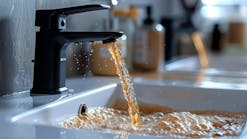The installation of ozone equipment on well applications utilizes the same principles and techniques as chlorinators, air injection and softener systems. There are only minor variations in sequence, parts and details.
Ozone Injection Location
To determine this you must first determine what is going to activate the ozonator. Will it be a pressure switch or a flow switch? To answer this you must first determine if you are treating all the water from the well or separating the house use from another use such as irrigation, water to air heat pumps, livestock and/or multiple homes.
* Pressure Switch--This method uses the well pumps pressure switch to activate the ozonator, which means that all the water is treated, and the ozonator will operate the entire time the well pump operates. This is a preferred method unless the well pumps cycle will cause undue "wear-n-tear" (such as with irrigation systems).
* Flow Switch--This method uses a flow-activated switch to turn on the ozonator, which means that not all the water is treated, and the ozonator will operate only when water is used in the home. This method is preferable to the immense wear-n-tear that could occur with irrigation or similar operation/cycles. It also is optimum when there is other usage that is not to be ozonated.
Ozone Injection Location
The ozone must be injected into the water after the well pump and prior to the pressure tank when using the pressure switch actuation.
Ozone Injection Devices
You have the choice of injecting the ozone via an ozone pump or a venturi.
Ozone Pump
An ozone pump (OP) compresses and injects the ozone without any restriction of flow or pressure. The OP can inject in any pipeline in any location. It is a specially designed compressor that is not compromised by ozone gas. However, there are moving parts that may need service depending on length of running time and environmental conditions. This service easily is accomplished with a minimum of parts called a rebuild kit. The OP eliminates the guesswork and restrictions associated with venturis and can inject 2.5 to 4 times more gas by volume.
Venturi
A venturi is a device that restricts flow and pressure in order to create a pressure differential that induces a vacuum. They practically are service-free but are subject to problems with the restriction of flow and pressure. They must be installed prior to the pressure tank and as close to the well pump as possible. Booster pumps are needed quite often depending on the hydraulics of the system. Venturis must be sized exactly to the gpm and psi recovery rate. The amount of vacuum must be tested to ascertain that the proper volume of ozone is being injected.
Ozone Injection Location (FS)
The ozone is injected on the line that is to be treated, which usually is after the pressure tank and all other branches. The ozone pump injector is the only device applicable to the flow switch activation method.
Clean/Dry Air Intake
As discussed before in a previous column, the air dryer is an option to reduce possible service on the ozone pump by reducing the amount of moisture that enters the ozonator.
Off Gas/Contact Tank (OGT)
The OGT is composed of an empty tank, an inlet/outlet head, vent device and flow separator. The ozonated water enters the top of the tank and circulates down to approximately half way. Then the ozone bubbles try to rise. The rising bubbles mix with gas that is trying to go down (toward the outlet) during usage. All the bubbles rise and are released at the top through the vent.
The vent can be either a float type, which can be used with the venturi, or an electric/self-cleaning type, which is common with the ozone pump injection method. Care must be taken to ensure that the vent can release the amount of gas injected. Float-type vents tend to release a much lower volume, which can lead to air-locking conditions.
Filtration
The filtration should be merely mechanical and not require further oxidative-type media, meaning that if the ozone equipment has been sized and installed properly, all the water should be treated and all of the iron, sulfur and manganese should be oxidized. This means that iron, sulfur and manganese have formed a larger particle that easily can be filtered. Media such as Birm, Greensand, Pyrelox and KDF that further oxidation should not be required.
The media of choice should be non-porous, inert, easily backwashed at a minimal flow rate and approximately 5 micron. There are only two media that fit this description: SP10 and ceramic media. Both media yield high service flow rates while requiring low backwash rates.
As with any mechanical filtration and for most applications, backwash with water only is all that is required.
It is paramount to size the filter according to the gpm flow, gpd usage and water quality.
Next month's column will discuss ozone system troubleshooting and service.
Download: Here


